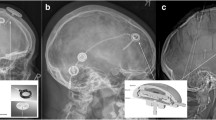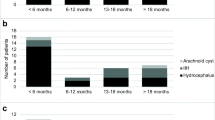Abstract
Background
The M.scio telesensor (Aesculap-Miethke, Germany) is a device integrated within a ventriculoperitoneal (VP) shunt for non-invasive measurement of the intracranial pressure (ICP). The purpose of this study was to analyze the telemetric recordings with the M.scio system in shunted patients with idiopathic intracranial hypertension (IIH), in order to determine reference values and assist the interpretation of telemetric data.
Methods
This was a cohort study of consecutive patients with fulminant IIH who underwent primary VP shunt insertion between July 2019 and June 2022. The first telemetric measurements after surgery in the sitting and supine positions were analyzed. Telemetric ICP values, wave morphology, and pulse amplitude were determined for functioning and malfunctioning shunts.
Results
Fifty-seven out of 64 patients had available telemetric recordings. The mean ICP was − 3.8 mmHg (standard deviation (SD) = 5.9) in the sitting and 16.4 mmHg (SD = 6.3) in the supine position. The ICP curve demonstrated pulsatility in 49 (86%) patients. A pulsatile curve with mean ICP in the above ranges indicated a functioning shunt, whereas the lack of pulsatility was challenging to interpret. There was a significant positive correlation between ICP versus amplitude, ICP versus body mass index (BMI), and amplitude versus BMI.
Conclusions
This clinical study defined ICP values and curves in IIH patients with a shunt. The results will assist the interpretation of telemetric ICP recordings in clinical decision making. More research is required to model longitudinal recordings and explore the link between telemetric measurements with clinical outcomes.



Similar content being viewed by others
Data Availability
The data that support the findings of this study are not openly available due to confidentiality reasons and are available from the corresponding author upon reasonable request. Data are located in controlled access data storage at University Hospitals Birmingham NHS Foundation Trust.
Abbreviations
- AMP:
-
Amplitude
- BMI:
-
Body mass index
- CSF:
-
Cerebrospinal fluid
- IIH:
-
Idiopathic intracranial hypertension
- ICP:
-
Intracranial pressure
- SD:
-
Standard deviation
- VP:
-
Ventriculoperitoneal
References
Andresen M, Hadi A, Petersen LG, Juhler M (2015) Effect of postural changes on ICP in healthy and ill subjects. Acta Neurochir 157:109–113
Antes S, Stadie A, Müller S, Linsler S, Breuskin D, Oertel J (2018) Intracranial pressure-guided shunt valve adjustments with the miethke sensor reservoir. World Neurosurg 109:e642–e650
Behrens A, Lenfeldt N, Qvarlander S, Koskinen LO, Malm J, Eklund A (2013) Are intracranial pressure wave amplitudes measurable through lumbar puncture? Acta Neurol Scand 127(4):233–241
Bjornson A, Henderson D, Lawrence E, McMullan J, Ushewokunze S (2021) The sensor reservoir-does it change management? Acta Neurochir (Wien) 163(4):1087–1095
Chapman PH, Cosman ER, Arnold MA (1990) The relationship between ventricular fluid pressure and body position in normal subjects and subjects with shunts: a telemetric study. Neurosurgery 26(2):181–189
Chari A, Dasgupta D, Smedley A, Craven C, Dyson E, Matloob S, Thompson S, Thorne L, Toma AK, Watkins L (2017) Intraparenchymal intracranial pressure monitoring for hydrocephalus and cerebrospinal fluid disorders. Acta Neurochir 159:1967–1978
Czosnyka M, Pickard JD (2004) Monitoring and interpretation of intracranial pressure. J Neurol Neurosurg Psychiatry 75(6):813–821
D'Antona L, Craven CL, Bremner F, Matharu MS, Thorne L, Watkins LD, Toma AK (2021) Effect of position on intracranial pressure and compliance: a cross-sectional study including 101 patients. J Neurosurg. 1–9. https://doi.org/10.3171/2021.6.JNS203573. Epub ahead of print
Eide PK, Kerty E (2011) Static and pulsatile intracranial pressure in idiopathic intracranial hypertension. Clin Neurol Neurosurg 113(2):123–128
Eide PK (2021) Abnormal intracranial pulse pressure amplitude despite normalized static intracranial pressure in idiopathic intracranial hypertension refractory to conservative medical therapy. Life (Basel) 11(6):537
Galloway L, Karia K, White AM, Byrne ME, Sinclair AJ, Mollan SP, Tsermoulas G (2021) Cerebrospinal fluid shunting protocol for idiopathic intracranial hypertension for an improved revision rate. J Neurosurg 136(6):1–6
Hamedani AG, Thibault DP, Revere KE, Lee JYK, Grady MS, Willis AW, Liu GT (2020) Trends in the surgical treatment of pseudotumor cerebri syndrome in the United States. JAMA Netw Open 3(12):e2029669
Hoffmann J, Mollan SP, Paemeleire K, Lampl C, Jensen RH, Sinclair AJ (2018) European headache federation guideline on idiopathic intracranial hypertension. J Headache Pain 19(1):93
Kaipainen AL, Martoma E, Puustinen T, Tervonen J, Jyrkkänen HK, Paterno JJ, Kotkansalo A, Rantala S, Vanhanen U, Leinonen V, Lehto SM, Iso-Mustajärvi M, Elomaa AP, Qvarlander S, Huuskonen TJ (2021) Cerebrospinal fluid dynamics in idiopathic intracranial hypertension: a literature review and validation of contemporary findings. Acta Neurochir (Wien) 163(12):3353–3368
Korfias SI, Banos S, Alexoudi A, Themistoklis K, Vlachakis E, Patrikelis P, Gatzonis S, Sakas DE (2021) Telemetric intracranial pressure monitoring: our experience with 22 patients investigated for intracranial hypertension. Br J Neurosurg 35(4):430–437
Miyake H, Ohta T, Kajimoto Y, Matsukawa M (1997) A new ventriculoperitoneal shunt with a telemetric intracranial pressure sensor: clinical experience in 94 patients with hydrocephalus. Neurosurgery 40(5):931–935
Mollan SP, Davies B, Silver NC, Shaw S, Mallucci CL, Wakerley BR, Krishnan A, Chavda SV, Ramalingam S, Edwards J, Hemmings K, Williamson M, Burdon MA, Hassan-Smith G, Digre K, Liu GT, Jensen RH, Sinclair AJ (2018) Idiopathic intracranial hypertension: consensus guidelines on management. J Neurol Neurosurg Psychiatry 89(10):1088–1100
Mollan SP, Sinclair AJ (2021) Outcomes measures in idiopathic intracranial hypertension. Expert Rev Neurother 21(6):687–700
Mollan SP, Mytton J, Tsermoulas G, Sinclair AJ (2021) Idiopathic intracranial hypertension: evaluation of admissions and emergency readmissions through the hospital episode statistic dataset between 2002–2020. Life (Basel) 11(5):417
Mollan SP, Mitchell JL, Ottridge RS, Aguiar M, Yiangou A, Alimajstorovic Z, Cartwright DM, Grech O, Lavery GG, Westgate CSJ, Vijay V, Scotton W, Wakerley BR, Matthews TD, Ansons A, Hickman SJ, Benzimra J, Rick C, Singhal R, Tahrani AA, Brock K, Frew E, Sinclair AJ (2021) Effectiveness of bariatric surgery vs community weight management intervention for the treatment of idiopathic intracranial hypertension: a randomized clinical trial. JAMA Neurol 78:678–686
Mollan SP, Mitchell JL, Yiangou A, Ottridge RS, Alimajstorovic Z, Cartwright DM, Hickman SJ, Markey KA, Singhal R, Tahrani AA, Frew E, Brock K, Sinclair AJ (2022) Association of amount of weight lost after bariatric surgery with intracranial pressure in women with idiopathic intracranial hypertension. Neurology 99(11):e1090–e1099. https://doi.org/10.1212/WNL.0000000000200839
Omidbeigi M, Mousavi MS, Meknatkhah S, Edalatfar M, Bari A, Sharif-Alhoseini M (2021) Telemetric intracranial pressure monitoring: a systematic review. Neurocrit Care 34(1):291–300
Pedersen SH, Norager NH, Lilja-Cyron A, Juhler M (2020) Telemetric intracranial pressure monitoring in children. Childs Nerv Syst 36(1):49–58
Pennacchietti V, Prinz V, Schaumann A, Finger T, Schulz M, Thomale UW (2020) Single center experiences with telemetric intracranial pressure measurements in patients with CSF circulation disturbances. Acta Neurochir (Wien) 162(10):2487–2497
Rot S, Dweek M, Gutowski P, Goelz L, Meier U, Lemcke J (2020) Comparative investigation of different telemetric methods for measuring intracranial pressure: a prospective pilot study. Fluids Barriers CNS 17(1):63
Thompson SD, Coutts A, Craven CL, Toma AK, Thorne LW, Watkins LD (2017) Elective ICP monitoring: how long is long enough? Acta Neurochir 159:485–490
Tsermoulas G, Thant KZ, Byrne ME, Whiting JL, White AM, Sinclair AJ, Mollan SP (2022) The Birmingham standardised idiopathic intracranial hypertension shunt protocol: technical note. World Neurosurg S1878–8750(22):01283–01289
Velazquez Sanchez VF, Al Dayri G, Tschan CA (2021) Long-term telemetric intracranial pressure monitoring for diagnosis and therapy optimisation of idiopathic intracranial hypertension. BMC Neurol 21(1):343
Wakerley BR, Warner R, Cole M, Stone K, Foy C, Sittampalam M (2020) Cerebrospinal fluid opening pressure: the effect of body mass index and body composition. Clin Neurol Neurosurg 188:105597
Author information
Authors and Affiliations
Contributions
All authors contributed to the study’s conception and design. Material preparation, data collection, and analysis were performed by Fardad Afshari, Mahmoud Samara, Kyaw Zayar Thant, Marian Byrne, and Georgios Tsermoulas. The first draft of the manuscript was written by Fardad Afshari and Georgios Tsermoulas, and it was reviewed and edited by Alexandra Sinclair and Susan Mollan. All authors commented on previous versions of the manuscript. All authors read and approved the final manuscript.
Corresponding author
Ethics declarations
Ethical approval and consent to participate
All procedures performed in this study were in accordance with the ethical standards of University Hospitals Birmingham NHS Foundation Trust and with the 1964 Helsinki declaration and its later amendments or comparable ethical standards. All data included in the cohort were obtained as part of routine clinical practice, and this study was approved as service evaluation (Clinical Audit Registration & Management System number: 18463). Ethics approval by a research ethics committee was not required. All data were anonymized for analysis so that individual patients could not be identified, and patient consent was not required.
Conflict of interest
Professor Mollan has received Honoria from Novartis for speaking on fundoscopy, but within a National headache network meeting (2019); Chiesi (2020, 2021), Heidelberg Engineering (2019, 2020, 2021), and Teva (2019, 2021). Professor Mollan has served on advisory boards for Invex Therapeutics, Janssen, and Roche. Professor Mollan has received payment for consultancy work for Invex therapeutics (2020, 2021). Professor Sinclair has received speaker fees and Honoraria from Novartis (erenumab) and Allergan (BOTOX), in addition, Invex therapeutics, a company director with salary and stock options (2019, 2020). Professor Sinclair is supported by a Sir Jules Thorn Award for Biomedical Research.
Additional information
Publisher's note
Springer Nature remains neutral with regard to jurisdictional claims in published maps and institutional affiliations.
Rights and permissions
Springer Nature or its licensor (e.g. a society or other partner) holds exclusive rights to this article under a publishing agreement with the author(s) or other rightsholder(s); author self-archiving of the accepted manuscript version of this article is solely governed by the terms of such publishing agreement and applicable law.
About this article
Cite this article
Afshari, F.T., Samara, M., Thant, K.Z. et al. Interpretation of telemetric intracranial pressure recordings in people with idiopathic intracranial hypertension after shunt implantation. Acta Neurochir 165, 1523–1531 (2023). https://doi.org/10.1007/s00701-023-05572-z
Received:
Accepted:
Published:
Issue Date:
DOI: https://doi.org/10.1007/s00701-023-05572-z




